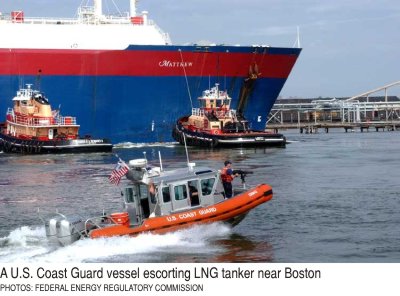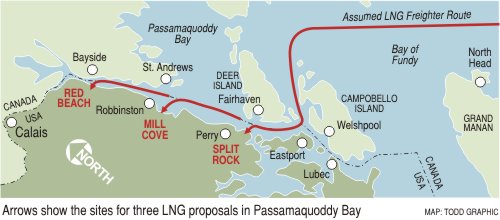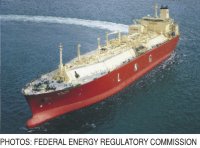
Despite rejections, LNG proposals move up the coast
Passamaquoddy Bay is no place for terminals, say opponents
By Maureen Kelly
Printer Friendly Page
The proposals follow several attempts by other developers to site LNG terminals in coastal Maine.
Over the past two years, Maine residents have rebuffed proposals in Harpswell, Cumberland, Yarmouth,
Gouldsboro and Searsport.
If approved in the Passamaquoddy region, the LNG facilities would be located on the U.S. shoreline
of the bay, which straddles the U.S./Canadian border. But since tankers making deliveries would have
to traverse Canadian waters to reach port, the Canadian government may ultimately determine whether
the American terminals are built.
Oklahoma-based Quoddy Bay LLC was the first to announce plans for a terminal on Passamaquoddy
tribal land that would include a pier with berths for two tankers and an eight-mile pipeline to
storage tanks in Robbinston, Maine. After residents in nearby Perry voted against the company's
proposal to site the facility at Gleason Cove last March, the company and tribal leaders reached
a controversial agreement in May for the lease of a site at Split Rock on the Pleasant Point
reservation.
Elsewhere in the Gulf of Maine, other energy companies are vying for approval to build terminals.
In Massachusetts, AES Corporation has proposed to build a facility in Boston Harbor on Outer Brewster
Island, part of a state and national park. Excelerate Energy and Neptune LNG are each planning
offshore terminals in federal waters off Massachusetts's North Shore.
Irving Oil and Repsol received approval from the Canadian government to jointly construct a
terminal in Saint John, New Brunswick, 60 miles from the U.S. border. The so-called Canaport
terminal will be operational by 2008 to serve the Canadian and U.S. markets. Canadian officials
consider Saint John a good location for the terminal since the city, home to an oil refinery, is
already industrialized, has infrastructure in place to minimize pollution and is on established
shipping routes.
Presently, the Distrigas terminal in Everett, Massachusetts, is the only LNG terminal in the
region, one of six in the United States.
Natural gas is contributing an ever larger share to New England's energy mix for heating homes
and generating electricity. Industry experts and public energy officials predict that demand will
soon outpace domestic supply and the region will need new sources of the fuel by the end of this
decade to reliably deliver during peak winter months. Liquid natural gas - imported from overseas,
gasified then shipped by pipeline to regional markets - is seen as one of the most viable options
for increasing supply. Natural gas is cleaner than other fossil fuels producing fewer greenhouse
gas emissions.
Yet opponents of the proposed projects believe that LNG's benefits are outweighed by the
potential for ecological and economic damage, and harm to humans that ships full of hazardous
cargo could present in the bay.
Hundreds of area residents participated in anti-LNG rallies and thousands signed petitions that
went to the government of Maine and the U.S. and Canadian federal governments, said Linda Godfrey,
coordinator of a cross-border grassroots organization, Save Passamaquoddy Bay. Several Canadian
politicians voiced opposition as well. In August, New Brunswick Premier Bernard Lord announced
that he wanted the Canadian federal government to reject the American proposals. Canada could
deny tankers access to its waters, blocking their route to port, as the nation did thirty years
ago when it barred oil tankers from those same waters because of the high ecological value of
the area and navigational risk.
LNG tankers as long as three football fields will have to navigate through the Bay of
Fundy - renowned for its extreme tides and strong winds and currents - to Head Harbour Passage
where tugboats would escort the tankers for a two-hour inland voyage. The passage is deep but
narrow, which would require tankers to run close to the shoreline. The ships would also have to
avoid a natural hazard called the Old Sow Whirlpool, the second largest whirlpool in the world.
The Head Harbour area is a rich feeding ground for birds and wildlife drawn to the clusters of
plankton and krill that are abundant there. Harbor porpoises, basking sharks, seals and finback,
humpback and minke whales inhabit the area. Endangered North Atlantic right whales migrate to the
Bay of Fundy in the summer and near proposed routes and tend to concentrate in protected zones east
of Grand Manan Island.
The impacts of LNG tanker traffic on wildlife will be investigated as the companies move forward
with their environmental impact statements. The Canadian government will also conduct a comprehensive
study that will look at the biological, social and economic impacts of the projects on Canada, said
Greg Peacock, executive director of Provincial Relations at Canada's Department of Fisheries and
Oceans.
Concerns over the projects' impact on the local economy have surfaced on both sides of the
border. The bay's natural resources are the backbone of a $1 billion “eco-economy” that employs
thousands in the tourism, aquaculture and fishing industries, said Art MacKay, executive director
of the St. Croix Estuary Project in St. Stephen, New Brunswick. He believes the exclusion zones
that would surround tankers en route to the terminals would disrupt commerce in the bay and that
local business could lose million of dollars due to these downtimes.
On the American side, others worry about the cost local communities would have to bear to enhance
emergency response and infrastructure to support an influx of workers.
“It's going to be a huge burden on towns,” Godfrey said.
Opponents also point out that looking to the LNG industry for economic development seems
shortsighted to some who expect few jobs will be available to locals after construction.
If the terminals are built, the U.S. Coast Guard and Transport Canada would have to coordinate
security for tankers transiting between the two nations' waters.
Security measures requiring lights, gunboats, surveillance and citizen refuge areas would “take
away from everything this place is,” said Godfrey, who believes that LNG terminals should be sited
in already industrialized areas.
Within the next few months, Godfrey and others on both sides of the issue will find out if the
U.S. and Canadian federal governments agree with them.
 THE DEBATE over the siting of liquefied natural gas (LNG) terminals has reached the northernmost
shores of Maine with three proposals to build terminals for offloading LNG from ships in the
deepwater ports of Passamaquoddy Bay. While the projects could provide a new source of energy
for New England and bring jobs to Maine's Washington County, opponents argue that an LNG terminal,
and the huge tankers that service it, will pose a threat to a vibrant coastal ecosystem and destroy
the region's tourist trade by industrializing small coastal communities, tribal lands and resort
towns. LNG terminals and their land-based facilities could also make the area vulnerable to terrorism
or an accidental spill, opponents say.
THE DEBATE over the siting of liquefied natural gas (LNG) terminals has reached the northernmost
shores of Maine with three proposals to build terminals for offloading LNG from ships in the
deepwater ports of Passamaquoddy Bay. While the projects could provide a new source of energy
for New England and bring jobs to Maine's Washington County, opponents argue that an LNG terminal,
and the huge tankers that service it, will pose a threat to a vibrant coastal ecosystem and destroy
the region's tourist trade by industrializing small coastal communities, tribal lands and resort
towns. LNG terminals and their land-based facilities could also make the area vulnerable to terrorism
or an accidental spill, opponents say.
Proposals in Maine and elsewhere
 Washington D.C.-based Downeast LNG wants to build a terminal, including a pier and storage tank,
at Mill Cove in Robbinston. And Washington County-St. Croix Development, a locally-owned concern
founded by two Maine state representatives - one of whom represents the Passamaquoddy tribe - became
the third entity to propose a terminal in the bay, at the Red Beach section of Calais.
Washington D.C.-based Downeast LNG wants to build a terminal, including a pier and storage tank,
at Mill Cove in Robbinston. And Washington County-St. Croix Development, a locally-owned concern
founded by two Maine state representatives - one of whom represents the Passamaquoddy tribe - became
the third entity to propose a terminal in the bay, at the Red Beach section of Calais.
Increased demand
Impact on local economies
© 2005 The Gulf of Maine Times
 LNG - natural gas cooled to its liquid state at -260o F (-162.2o C) - has been transported
across the world's oceans for over four decades. After delivery, LNG is either stored or heated
to turn it back into gas for delivery to homes and businesses.
LNG - natural gas cooled to its liquid state at -260o F (-162.2o C) - has been transported
across the world's oceans for over four decades. After delivery, LNG is either stored or heated
to turn it back into gas for delivery to homes and businesses.